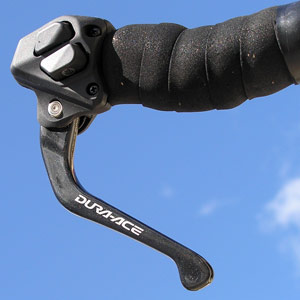Tour de Force
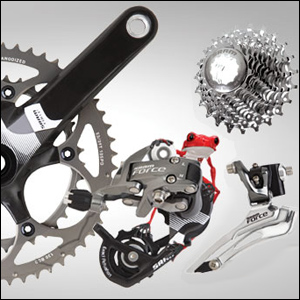
We polled Slowtwitchers around the time of Ironman Hawaii last year. We asked what gruppo was preferred, when both performance and value were considered. The winner? Shimano Ultegra. More than 1 in 3 of you selected that group.
Second was Dura Ace and third was SRAM Red, and those two high-end gruppos were pretty close. Behind that was SRAM Force, at 12 percent. Then Di2 at 9 percent—Shimano's incredible electronic group has since moved up in the poll, even when value is considered.
Interesting is that 105, Tiagra, Rival, Apex, are not even on your radar. In total, these four groups poll 10 percent. Boy, aren't we the snobs.
The discontinuity in this poll is where Force sits relative to Ultegra. If Shimano's ultra popular mid-priced gruppo is chosen at a rate of 36 percent; and if Dura Ace only barely outpolls Red; shouldn't Force be up there tugging at Ultegra's heels? Price-wise, the groups are fairly close—some Force parts are pricier, sometimes it's Ultegra.
Ultegra has won the battle of spec on OE tri bikes. So far. In the mid-priced tri bike arena, Ultegra dominates Force. What we tend to see are Force front derailleurs, for example, on otherwise SRAM Red bikes. There are some Force-equipped tri bikes out there, such as the Blue Triad, which we reviewed here.
But most of what we see in circa-$3500 bikes are Ultegra kits or we see Red with a bit of Force sifted in here and there.
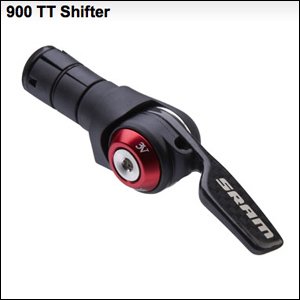
Like Ultegra, and Campagnolo Chorus (third down in Campy's food chain), Force is a pro-quality group. You'll find Force gruppos on the everyday trainers used by many of the North American continental teams (look on SRAM's list of sponsored teams and you'll see a lot of the sort of teams—such as Jelly Belly and Kelly Benefits—with riders likely to be training on Force).
Of course, the TT group will not feature a set of DoubleTap levers, rather you'd either ride SRAM's 500, 900 or its R2C (return to center) levers. Personally, I tend to like the 500 and 900 shifters because the shifting is spot-on perfect, and the paddles are bigger and fit my old and creaky hands. Force with either 500 or 900 (the same shifter, carbon versus aluminum paddle) seems to me an elegant mid-priced solution. The one particular benefit this group has over Ultegra is the shifter: Shimano has still not yet made a specifically-tasked bar-end shifter in a cabled system. More on this below.
The best use of a Force group is in a BB30-designed bike. The Force crankset is the progeny of the San Luis Obispo based Truvativ group, and the BB30 version is lighter, stiffer and offers more clearance than SRAM's GXP version. SRAM will sell you whatever you want, but it clearly favors products built around the BB30 standard.
Force was SRAM's original high-end group. It debuted before Red. It's a lightweight group, but, maybe/maybe not lighter than Ultegra depending on the frame; what calipers come with the frame; and the frame's BB standard. The rear derailleur is 15g lighter than Ultegra, the Force front derailleur is 5g heavier than Ultegra. Ultegra's cassette is a little lighter, the Force crank + BB is lighter, if it's the BB30 standard you're talking about.
This crankset, and the brake calipers, is what causes the overall groupkit to be lighter than Ultegra. If you choose the GXP crank/BB standard, and/or if the bike you're considering uses a proprietary set of calipers, the weight advantage of Force over Ultegra is diminished or lost.
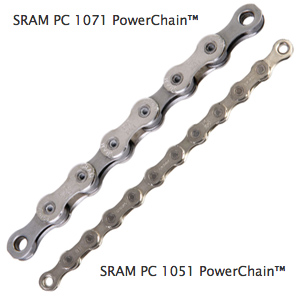
The performance advantage Force enjoys over Ultegra is in two areas, maybe a third and this is debatable.
First, the shifting is superior. This is not because the derailleur is better than Ultegra's derailleur, nor the cogs, the chain, the chainrings, or anything typically associated with shifting performance. Rather, it's simply due to the antiquated thumb shifter upon which Shimano relies for bar-end shifting—a product that's not made for the purpose, so both technology and ergonomics suffer.
Once you move to a modern shifter—say, STI or Di2—SRAM's shifting advantage over Shimano disappears. Indeed, on a TT bike, if what you want is the world's most precisely shifting bike, save your pennies and hang Di2 on your frame.
Force's second advantage is in the breadth of gearing available [See the correction on this at the bottom of the article]. In a timed race like triathlon, there is little value gained in muscling up a hill in a gear not small enough. Racing a triathlon either requires multiples of cassettes, changed out for the profile of the course, or it requires a wide-ratio gearbox. This, unless you live and race only in Minnesota or Florida. Shimano, happily, now offers an 11-28 gearbox and that's sufficient for most courses. And that's the limit—in toothsize—of what an Ultegra RD will handle.
Force, however, can be ridden with cogs up to 32 teeth, and SRAM offers an 11-32 gearbox just for the purpose. If you've got steep ups and gradual downs (think Wildflower Long Course), SRAM gives you options Shimano doesn't.
Finally, it's debatable whether a connecting link, or a pin, is more appropriate way to join a chain. I think it's moot, with this proviso: I think connecting pins—Shimano's choice—may be more prone to user error during installation than connecting links (SRAM's choice). Each company makes a great chain. Shimano possesses, in my view, the best and most experienced engineers in the bicycle business, with the longest tenure and strongest pedigree. But SRAM got a running start in the chain business when it purchased Sachs-Huret.
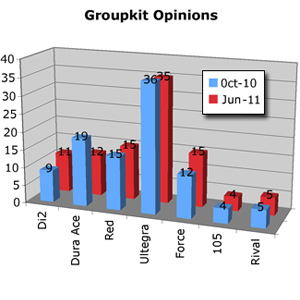
SRAM bought Sachs in 1997, exactly 100 years after Sachs developed the first bicycle freewheel. Through the acquisition SRAM inherited a slick chain and cassette system, eventually pairing it with Truvativ's crankset braintrust when SRAM acquired Truvativ in 2005. The Force group debuted a year after the Truvativ acquisition.
One caveat about the chain: I think there's an argument to be made for down-spec'ing from the Force 1071 chain to the 1051 chain. Yes, the 1071 is lighter, because of its hollow pins (see the pic above). But the 1051 is fully nickel-plated, and the way triathletes tend to take care of their bikes, I rather like the corrosion resistance more than 15g or 20g worth of weight savings.
As of this writing, we're about 350 votes into a new poll on the Slowtwitch site. It seems as if Slowtwitchers are slowly waking up to this group. Somewhat at the expense of Dura Ace 7900, it seems. But then many groupkits—including Di2—seem to be taking their own small bites out of 7900 (though one shouldn't make too much of a snapshot poll).
Force has a several-year window where it should be—that is to say, it has earned the right to be—spec'd by product managers, and desired by end-users, at a much greater rate than is the case now. That "window" to which I refer depends on how inexpensive and downstream electronic shifting gets; how quickly it gets there; and whether Shimano front-burners the TT shifters in these lower-end electronic groups I assume will debut at a rate of one new electronic group every year or two.
It's a sure bet that SRAM, Campagnolo, Visiontech, et al, will not be sitting on their hands as The Borg that is Shimano electronic moves through the cycling universe, gaining strength with every category it devours. We don't know what SRAM will answer with two or three years hence. Consequently, one can only look as far down the road as we have products announced and introduced. When one looks at what's visible on the horizon—for 2012— SRAM Force offers a much better value in TT/tri than its sales or public image enjoys.
[Publisher's note: Force does not enjoy an advantage over Ultegra in breadth of gears, as this article originally stated, at the point of initial publication. SRAM's WiFLi™ technology, while available in both Apex and Rival groups, is not a technology that is a part of the Force shift system. Accordingly, you're limited to 28t as your largest cog, both with Ultegra and Force. Each company offers long-cage options for those interested in broader gearing. A rider wanting to ride SRAM's Force group with an 11-32 cassette would then be well advised to swap out the Force RD with a Rival RD.]


